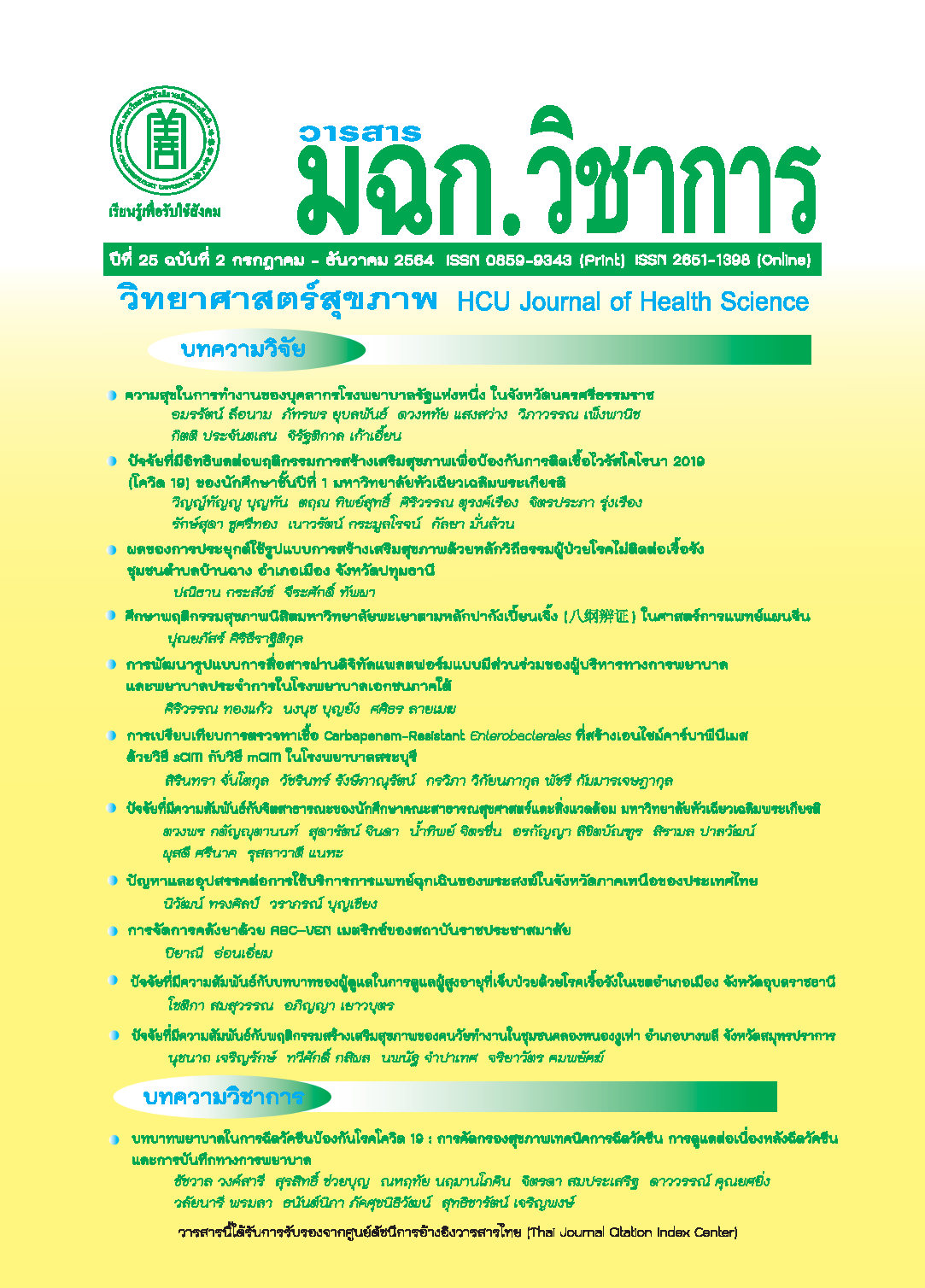การเปรียบเทียบการตรวจหาเชื้อ Carbapenem-Resistant Enterobacterales ที่สร้างเอนไซม์คาร์บาพีนีเมสด้วยวิธี sCIM กับวิธี mCIM ในโรงพยาบาลสระบุรี
คำสำคัญ:
Carbapenem-resistant Enterobacterales (CRE), คาร์บาพีนีเมส, simplified carbapenem inactivation method (sCIM), modified carbapenem inactivation method (mCIM)บทคัดย่อ
การศึกษานี้มีวัตถุประสงค์เพื่อเปรียบเทียบประสิทธิภาพของการตรวจหา CPE (carbapenemase-producing Enterobacterales) ทางฟีโนไทป์ ด้วยวิธี Simplified carbapenem inactivation method (sCIM) และวิธี Modified carbapenem inactivation method (mCIM) จากเชื้อ CRE (Carbapenem-resistant Enterobacterales) ที่แยกได้จากสิ่งส่งตรวจของผู้ป่วยในโรงพยาบาลสระบุรี จำนวน 104 สายพันธุ์ เปรียบเทียบกับวิธีทางจีโนไทป์ (Multiplex PCR; polymerase chain reaction) วิธี sCIM พัฒนาวิธีทำมาจาก mCIM โดยการป้ายเชื้อบนแผ่นยา Imipenem โดยตรงแทนการบ่มเพาะเชื้อใน Trypticase soy broth ที่มีแผ่นยา Meropenem เป็นเวลา 4 ชั่วโมง ผลการศึกษาพบความชุกของเชื้อ CRE ร้อยละ 1.38 จำแนกเป็นเชื้อ Klebsiella pneumoniae, Enterobacter cloacae และ Escherichia coli ร้อยละ 64.42 19.23 และ 16.35 ตามลำดับ เมื่อเปรียบเทียบผลการตรวจหา CPE พบว่า ทั้ง 2 วิธี และวิธี Multiplex PCR ให้ผลบวกตรงกันทั้งหมด 103 สายพันธุ์ และผลลบตรงกันทั้งหมด 1 สายพันธุ์ สอดคล้องกันร้อยละ 100 (Cohen’s kappa = 1.0, 95%CI =1.0-1.0) จะเห็นว่าวิธี sCIM ทำได้ง่าย ลดขั้นตอนในการทำ สะดวก ลดต้นทุน และไม่ต้องใช้เครื่องมือพิเศษ แต่ต้องระวัดระวังเกี่ยวกับปริมาณเชื้อที่ป้าย ดังนั้นวิธี sCIM อาจมีความเหมาะสมในการนำมาใช้ในงานประจำของห้องปฏิบัติการจุลชีววิทยาคลินิก
Downloads
เอกสารอ้างอิง
กระทรวงสาธารณสุข กระทรวงเกษตรและสหกรณ์. แผนยุทธศาสตร์การจัดการการดื้อยาต้านจุลชีพประเทศไทย พ.ศ. 2560–2564 [อินเทอร์เน็ต]. 2559 [เข้าถึงเมื่อ 13 เมษายน 2563]. เข้าถึงได้จาก: http://narst.dmsc.moph.go.th/documentation/AMR%20strategy%202560-2564.pdf
World Health Organization. Global priority list of antibiotic-resistant bacteria to guide research, discovery, and development of new antibiotic [Internet]. 2017 [cited 2021 Apr 8]. Available from: https://www.who.int/medicines/publications/WHO-PPL-Short_Summary_25Feb-ET_NM_WHO.pdf?ua=1
Suay-García B and Pérez-Gracia MT. Present and future of carbapenem-resistant Enterobacterales (CRE) infections. Antibiotics [Internet]. 2019 [cited 2020 May 10]; 8,122-38. Available from: https://www.mdpi.com/2079-6382/8/3/122/htm
Tamma PD, Simner PJ. Phenotypic detection of carbapenemase-producing organisms from clinical isolates. J Clin Microbiol 2018;56(11):e01140-18.doi: 10.1128/JCM.01140-18.
วันทนา ปวีณกิตติพร. การพัฒนาระบบเฝ้าระวังเชื้อดื้อยาระดับชาติและระดับโลก [อินเทอร์เน็ต]. 2559 [เข้าถึงเมื่อ 13 เมษายน 2563]. เข้าถึงได้จาก: http://nih.dmsc.moph.go.th/data/data/59/22_6/3.pdf
Al-Zahrani IA. Routine detection of carbapenem-resistant gram-negative bacilli in clinical
laboratories. Saudi Med J 2018;39(9):861-72.
Nordmann P, Poirel L, Dortet L. Rapid detection of carbapenemase-producing Enterobacterales. Emerg Infect Dis 2012;18(9):1503-7.
Zwaluw Kvd, Haan Ad, Gerlinde N, Bootsma HJ, Neeling A, Schouls LM. The carbapenem inactivation method (CIM), a simple and low-cost alternative for the Carba NP test to assess phenotypic carbapenemase activity in gram-negative rods. PLOS ONE 2015;1-13. doi:10.1371/journal.pone.0123690.
Pierce VM, Simner PJ, Lonsway DR, Roe-Carpenter DE, Johnson JK, Brasso WB, et al. The modified carbapenem inactivation method (mCIM) for phenotypic detection of carbapenemase production among Enterobacterales. J Clin Microbiol 2017;55:2321–33.
Clinical and Laboratory Standard Institute. Performance standards for antimicrobial susceptibility testing; Twenty-seventh information supplement. CLSI document M100-S29. Wayne, PA. 2017.
Jing X, Zhou H, Min X, Zhang X, Yang Q, Du S, et al. The simplified carbapenem inactivation method (sCIM) for simple and accurate detection of carbapenemase-producing gram-negative bacilli. Front Microbiol 2018;9(2391):1-7.
ศิรประภา มินาผล, สุรศักดิ์ แว่นรัมย์, จิราภรณ์ นิลสกุล, มารุตพงศ์ ปัญญา, ภาวนา พนมเขต. ความชุกของแบคทีเรียวงศ์เอ็นเทอโรแบคทีเรียซีอีที่ผลิตเอนไซม์ Carbapenemase ในโรงพยาบาลสรรพสิทธิประสงค์. วารสารเทคนิคการแพทย์และกายภาพบำบัด 2562;31:105-13.
สุกัญญา บัวชุม, ไพโรจน์ โจวตระกูล, สุชาดา วงพระจันทร์. ปัจจัยที่มีความสัมพันธ์กับการติดเชื้อแบคทีเรียกลุ่ม Enterobacterales ที่ดื้อต่อยา Carbapenem: CRE ในผู้ป่วยที่เข้ารับการรักษาในโรงพยาบาลพิจิตร. วารสารวิจัยและวิชาการสาธารณสุขจังหวัดพิจิตร 2563;1:1-9.
Laolerd W, Akeda Y, Preeyanon L, Ratthawongjirakul P, and Santanirand P. Carbapenemase-producing carbapenem-resistant Enterobacterales from Bangkok, Thailand, and their detection by the Carba NP and modified carbapenem inactivation method tests. Microb Drug Resist 2018;24(7):1006-11.
วีวรรณ อาชีวะ. ความชุกของเอนไซม์ดื้อยากลุ่ม Carbapenems ที่แยกได้จากเชื้อดื้อยา Carbapenem-resistant Enterobacterales ในโรงพยาบาลพระปกเกล้า ปี พ.ศ. 2555 - 2556. วารสารศูนย์การศึกษาแพทยศาสตร์คลินิกโรงพยาบาลพระปกเกล้า 2559;33(4):136-7.
Yamada K, Sasaki M, Murakami H, Aoki K, Morita T, Ishii Y. Evaluation of the simplified carbapenem inactivation method as a phenotypic detection method for carbapenemase-producing Enterobacterales. J Microbiol Methods [Internet]. 2021 [cited 2021 Sep 20];1-5. Available from: https://doi.org/10.1016/j.mimet.2021.106273
ดาวน์โหลด
เผยแพร่แล้ว
รูปแบบการอ้างอิง
ฉบับ
ประเภทบทความ
สัญญาอนุญาต
ลิขสิทธิ์ (c) 2021 วารสาร มฉก.วิชาการ

อนุญาตภายใต้เงื่อนไข Creative Commons Attribution-NonCommercial-NoDerivatives 4.0 International License.
บทความที่ได้รับการตีพิมพ์เป็นลิขสิทธิ์ของวารสารวิทยาศาสตร์สุขภาพและสุขภาวะ
ข้อความที่ปรากฏในบทความแต่ละเรื่องในวารสารวิชาการเล่มนี้เป็นความคิดเห็นส่วนตัวของผู้เขียนแต่ละท่านไม่เกี่ยวข้องกับมหาวิทยาลัยหัวเฉียวเฉลิมพระเกียรติ และคณาจารย์ท่านอื่นๆในมหาวิทยาลัยฯ แต่อย่างใด ความรับผิดชอบองค์ประกอบทั้งหมดของบทความแต่ละเรื่องเป็นของผู้เขียนแต่ละท่าน หากมีความผิดพลาดใดๆ ผู้เขียนแต่ละท่านจะรับผิดชอบบทความของตนเองแต่ผู้เดียว




